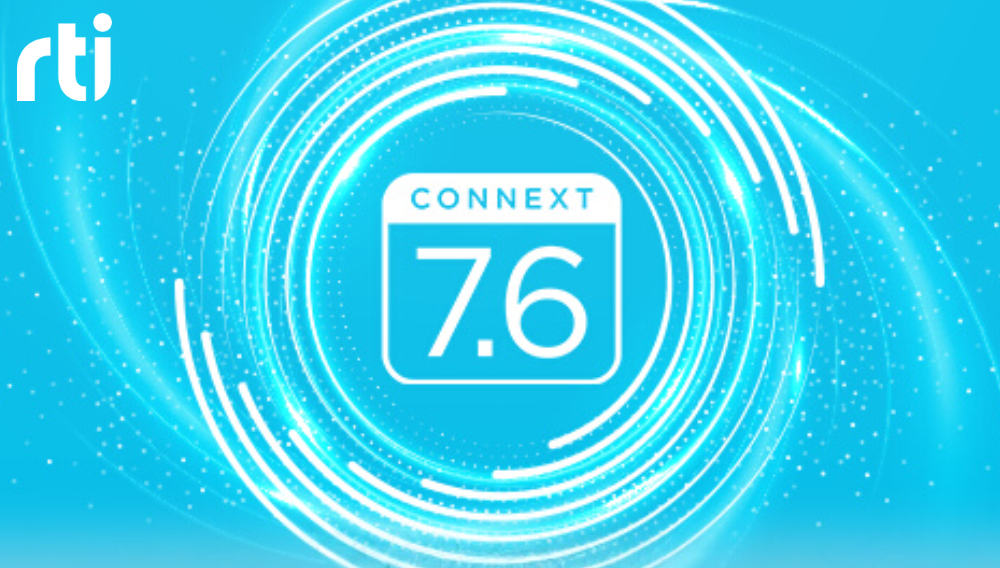4 min read
Connext 7.6: Smarter at the Edge, Safer at Scale, Seamless Across Networks
 Juhi Ranjan
:
October 30, 2025
Juhi Ranjan
:
October 30, 2025

Across industries, the world is rapidly transitioning to software-defined systems – from vehicles and medical devices to industrial equipment and defense platforms. As this transition accelerates, the next frontier isn’t just about making each system smarter; it’s about enabling these “software-defined things” to work together as one.
That’s where data-centric design becomes essential. It’s not enough to connect endpoints – the system itself must ensure that data is available where it’s needed, when it’s needed, and in a form the system can trust. That’s the foundation of RTI Connext, and with the launch of Connext 7.6, we’re bringing new capabilities that make this vision real.
Connext 7.6 is more than a feature release: it’s the clearest preview yet of our upcoming Connext 7.7 Long-Term Support (LTS) offering. That means every capability you adopt today not only solves immediate challenges, but also becomes part of the long-term foundation for your mission-critical systems. Here are three application scenarios where Connext 7.6 directly addresses real-world problems:
Smarter Edge Devices
Edge devices such as imaging systems in hospitals, robots on factory floors, or perception modules in autonomous vehicles all face the same problem: They must process massive amounts of data with limited compute and memory resources. Developers often resort to manual workarounds such as configuring memory for data types by hand, cleaning up threads manually or writing custom filtering logic. These tasks aren’t just tedious; they introduce risk and distract from building real application functionality.
Connext 7.6 addresses these pain points head-on. One key addition is automatic memory management for unbounded types. Unbounded types such as variable-length strings, arrays, or sequences are essential for modeling real-world data that doesn’t always fit into a fixed size. But they are tricky to configure, and poorly chosen limits can cause either wasted resources or runtime crashes. With Connext 7.6, these types are managed automatically, so developers no longer have to worry about sizing them manually.
Another improvement comes from smarter content filtering that scales across multicore processors. In practice, this means developers can filter and deliver only the data that matters; say, sensor values within a certain range without bottlenecking the writer or starving the reader. Combined with automatic thread cleanup and other resource optimizations, edge systems run faster and more predictably. And when it comes to building and configuring these systems, the AI-assisted System Designer guides architects through Quality of Service (QoS) choices, code generation, and troubleshooting, all in natural language.
The result? Embedded systems that scale cleanly at the edge, giving developers back their time to focus on application logic instead of middleware plumbing.
Securing Mission-Critical Systems
Security is one of the toughest challenges in distributed systems. In connected hospitals, energy grids, or defense networks, a single weak link can compromise the entire system. Despite this truism, securing large deployments has historically been brittle because policies were tied to endpoint machines or users, rather than to the data itself. And in dynamic systems where participants join and leave frequently, static policies simply don’t hold up.
Connext 7.6 introduces flexibility into the security model. With Online Certificate Status Protocol (OCSP) validation, systems can now check participant identities in real time, ensuring certificates haven’t been revoked. The addition of participant removal allows architects to rotate key materials and remove non-compliant participants without shutting down or disrupting the rest of the system.
Beyond identity, Connext 7.6 enhances data-centric security through domain tags and pattern-based permissions. Domain tags let architects partition and isolate subsystems within a larger deployment, while wildcard-style permissions make it easier to configure access for groups of participants. For example, in a hospital system, imaging devices could be isolated from patient monitoring systems while still sharing the data needed for integrated workflows.
These enhancements make it possible to enforce security that adapts dynamically to the system, without compromising availability. In other words, Connext 7.6 brings security that scales with the system.
WAN as Just Another Edge
Increasingly, systems aren’t confined to a single site. A manufacturing operation may have multiple plants sharing data over wide-area networks (WANs). Defense platforms may need to operate across air, sea, and ground networks. And medical providers may connect devices across clinics and cloud-based analysis platforms. In all of these cases, WAN connectivity has traditionally been the weak link, as it is often plagued by packet fragmentation, jitter, and limited visibility into what is happening remotely.
Connext 7.6 turns WAN into just another edge. A smarter default transport configuration avoids IP fragmentation issues, making communication more reliable across geographically distributed systems. At the same time, the Administration Console, Connext’s developer tool, can now observe and analyze remote systems in real time, even across WAN boundaries. This gives operators and architects the ability to see how their distributed system is behaving end-to-end, not just locally.
For developers and architects, this means WAN links no longer need to be treated as “special cases.” Systems can be designed as if WAN is simply another extension of the edge, with Connext’s data-centric backbone ensuring that the right data flows reliably no matter the distance.
Connext 7.6 is a Preview of the Future
Connext 7.6 is about solving the practical problems that developers and architects face every day: resource bottlenecks at the edge, brittle security at scale, and unreliable WAN connectivity. As the final release before our Connext 7.7 LTS, every capability in Connext 7.6 is part of the long-term foundation that will power your systems for the next decade.
Download & try Connext 7.6 today and prepare your systems for the long-term foundation of the upcoming Connext 7.7 LTS.
Note - An Early Access Release (EAR), Connext 7.6 is intended for development and evaluation rather than production. We encourage you to explore its capabilities and see how they can accelerate your path to Connext 7.7 LTS.
About the author:
 Juhi Ranjan, Senior Group Product Manager, RTI
Juhi Ranjan, Senior Group Product Manager, RTI
Juhi Ranjan is the Senior Group Product Manager at RTI, responsible for aligning market needs with RTI's flagship products. She is responsible for all aspects of the product strategy for Connext Professional, from conception to launch. Additionally, she oversees a team of product managers at RTI who are responsible for driving product initiatives.
Posts by Tag
- Developers/Engineer (179)
- Technology (78)
- Connext Suite (77)
- News & Events (74)
- 2020 (54)
- Standards & Consortia (51)
- Aerospace & Defense (49)
- Automotive (36)
- 2023 (34)
- 2022 (29)
- IIoT (27)
- Leadership (24)
- 2024 (22)
- Healthcare (21)
- Connectivity Technology (20)
- Cybersecurity (20)
- 2021 (18)
- 2025 (17)
- Culture & Careers (15)
- Military Avionics (15)
- FACE (13)
- Connext Pro (10)
- JADC2 (10)
- ROS 2 (10)
- Connext Tools (7)
- Connext Micro (6)
- Databus (6)
- Transportation (5)
- Case + Code (4)
- Connext (4)
- Connext Cert (4)
- Energy Systems (4)
- FACE Technical Standard (4)
- Oil & Gas (3)
- Research (3)
- Robotics (3)
- #A&D (2)
- AI (2)
- Connext Conference (2)
- Edge Computing (2)
- MDO (2)
- MS&T (2)
- RTI Labs (2)
- TSN (2)
- ABMS (1)
- C4ISR (1)
- DOD (1)
- ISO 26262 (1)
- L3Harris (1)
- LabView (1)
- MOSA (1)
- MathWorks (1)
- National Instruments (1)
- Simulation (1)
- Tech Talks (1)
- UAM (1)
- Videos (1)
- eVTOL (1)
 Success-Plan Services
Success-Plan Services